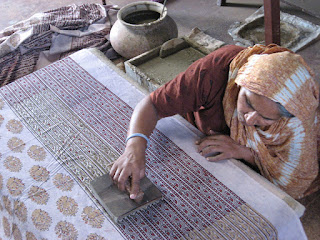In India, there are many different techniques of hand printing prevalent since ancient times. While some prints are stamped by hand using wooden blocks carved with patterns, others are done using the tie and dye technique and many others use the resist dye technique, the options are innumerable. The one common feature across all authentic and traditional hand printed silk sarees is that they use 100% natural colors and dyes. Some of the most popular prints that have found much ado and appreciated the world over are:
Block Printing:
Block printing known to have originated in China
towards early 3rd century had its presence felt in Egypt and some Asian
countries around the 4th century, from where it spread to Europe and other
places. In hand block printing, the design is first drawn on wood using a sharp
needle and then the desired design is carved using the chisel, hammer, file,
nails etc. The printing involves laying the cloth/fabric, which is to be
printed, on flat tables and impressions are made using the beautifully carved
blocks. In case of direct printing, the block is dipped in the colored dye and
impressions are made. In case of resist dyeing, impression of an impermeable
material (clay, resin, wax etc) is made on the fabric which is then dyed in the
desired shade. The block image remains unprinted and reappears in reverse.
Natural and vegetable sources are used for dyes.
Some of the popular block prints are:
Bagru Print: Bagru is done
by printing dark or coloured motifs on a cream or dyed background. This process
involves the use of natural mordants like harda and alum to capture
the natural colours that are printed on the fabric using the pattern blocks.
The process of block printing is not only painstakingly laborious but anciently
beautiful. The technique has been perfected by the people of Rajasthan over
more than 1,000 years.
Dabu Print: The
Resist Process called Dabu involves using wax or gum clay mixed with resin with
the help of brush, block or hand that is then applied to the portions of the
cloth and the color is then applied to it. The wax is then washed off in hot or
flowing water. Block printing is done on the portion of the cloth where the
original colour is retained. The fabric is highlighted by printing specific
outlines and patterns against the contrast colour.
Batik Print:
Batik is yet another popular print motif that has its origins in South East
Asia. Similar to Dabu print, Batik print involves the process of dyeing fabric
by making use of a resist technique, covering patches of fabric with
dye-resistant substance to prevent them from absorbing colors. Nature inspired
motifs like flowers & animals are a feature of Batik prints.
Ajrakh Print: Mostly
found on shawls and carpets, Ajrakh is a unique form of block print that is
popular in Sindh, Pakistan; Kutch, Gujarat and Rajasthan . These prints include
designs and patterns made using block printing by stamps. Common colours used
include blue, red, black, yellow and green but the color palate is wider in
current times considering changing trends. Ajrakh printing uses natural dyes
including vegetable dyes and mineral dyes, with Indigo being the key dye.
Some of the other popular hand prints are:
Bandhani:One of the most famous textile patterns of
India, Bandhani is a centuries old tradition of Gujarat. An art that involves
highly skilled process, the textile is decorated by plucking the cloth
with the fingernails into many tiny bindings called dockets that form a
figurative design. It features patterns like dots, stripes, waves or squares
formed by first tying small portions of the fabric at intervals with continuous
thread to form interesting patterns, and then dyeing it. Bandhani
work in India was started by the Muslim Khatri Community of Kutch and since
then the tradition has been passed on from one generation to the other.
Kalamkari: An
ancient art that came into being when artists began illustrating stories as
opposed to narrating them, visually arresting Kalamkari prints are known for
the complexity of designs and usage of natural as well as organic dyes.
Originated about 3000 years ago, it derives its name from Kalam meaning Pen,
and Kari meaning work, literally meaning Pen-work. There are three styles of
Kalamkari paintings of which Masulipatnam
Kalamkari is influenced by
Persian motifs & designs and is done using hand carved blocks.
Image Courtesy:
http://bit.ly/2tUSC0v
http://bit.ly/2sPMK3j
http://bit.ly/2tLZkFD
http://bit.ly/2sQ4CLn
http://bit.ly/2st5hDb
http://bit.ly/2tPtszg
http://bit.ly/2tM60n2
http://bit.ly/2utD3cO
http://bit.ly/2sPQWjF
http://bit.ly/2tLZkFD








No comments:
Post a Comment